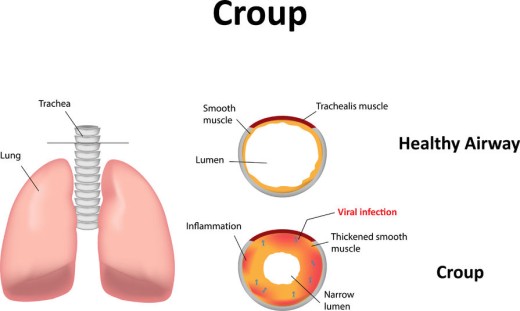Wishing everyone a safe and happy Christmas and New Year – Meri Kirihimete from the Healthify team.
Croup | Mate maremare pēpē
Key points about croup
- Croup is a viral illness in young tamariki (children) which causes narrowing of the upper airways.
- Croup is often a mild illness but can quickly become serious, so don't hesitate to get medical help.
- Croup symptoms are often worse at night or when your child is upset.
- If you are worried, see a healthcare provider.
- The content on this page comes from KidsHealth(external link).

Croup is a viral illness in young tamariki, which causes narrowing of the upper airways.
In croup, a viral infection causes inflammation, swelling and narrowing of the vocal cords, voice box and windpipe. This can make breathing more difficult. You may also hear a type of noisy breathing called stridor.

Image credit: 123rf
Tamariki with croup may have:
- a barking cough
- a type of noisy breathing called stridor
- a hoarse voice
- trouble breathing.
The symptoms of croup can get worse at night or when your child is upset.
Before the cough and breathing trouble develop, your child may have other symptoms such as:
- a sore throat
- a fever
- red eyes
- a runny nose
- being off their food.
How long will symptoms last?
Stridor may last for a few days. The cough may last for up to a week or so.
If you think your child has croup, call Healthline on 0800 611 116 or see a healthcare provider.
See a healthcare provider
A healthcare provider may prescribe a steroid medicine for croup. This reduces the swelling in your child's airway and helps them to breathe more easily. It doesn't change the cough but does reduce the stridor. Steroids work for about 48 hours.
Antibiotics don't help tamariki with croup because it's caused by a virus.
Calm and comfort your child
If your child has croup, try to keep them calm and comfort them. Distress can make it harder for them to breathe and make the stridor worse.
Help with a sore throat or fever
You can give paracetamol if your child is miserable with a fever or has a sore throat. You must follow the dosage instructions on the bottle. It's dangerous to give more than the recommended dose. You can use our paracetamol dose calculator if you're not sure how much to give them.
Your child may prefer cool sips of fluid which can be soothing for a sore throat.
Don't use steam
Adding steam to the air used to be recommended but there is no evidence it actually helps. There have been several cases reported where tamariki have been badly burned from the hot water. For these reasons, healthcare providers don't recommend using steam for croup.
Take your child to a healthcare provider or the nearest hospital straight away if they:
- have stridor
- have trouble breathing
- are upset and you can't calm them
- you are worried for any other reason.
Call 111 within Aotearoa New Zealand (use the appropriate emergency number in other countries) and ask for urgent medical help if your child has any of the following:
|
In pēpi (babies) less than 6 months of age, or in tamariki older than 6 years of age, croup is less common. There could be another reason for their symptoms. See a healthcare provider for a check up.
Make sure your child is up to date with all their immunisations.
It's very uncommon for tamariki to have croup more than once a year. See a healthcare provider if your child has repeated episodes of stridor or a barking cough.
Signs that children are struggling to breathe(external link) KidsHealth NZ
Croup(external link) Asthma + Respiratory Foundation NZ
Croup(external link) Health New Zealand | Te Whatu Ora
Resources
What is croup?(external link) Asthma + Respiratory Foundation NZ
Credits: Content shared between HealthInfo Canterbury, KidsHealth and Healthify He Puna Waiora as part of a National Health Content Hub Collaborative.
Last reviewed:





